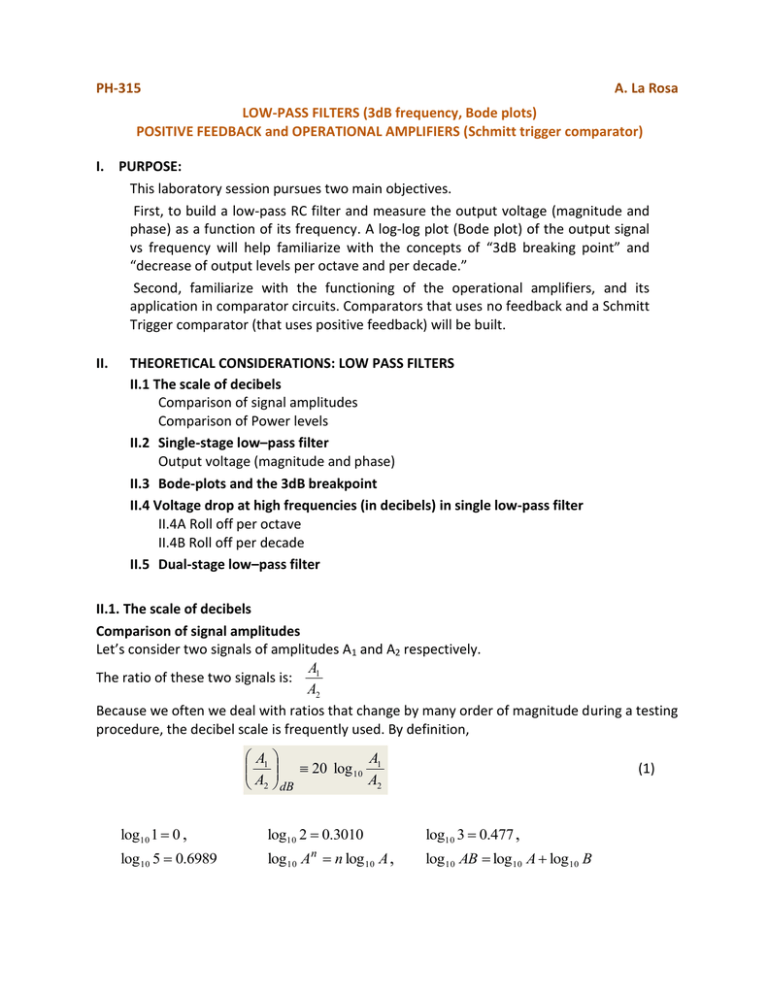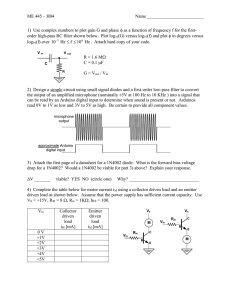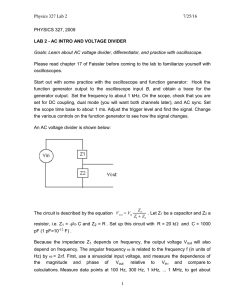PH-315 A. La Rosa LOW-PASS FILTERS (3dB frequency, Bode plots)
advertisement

PH-315 A. La Rosa LOW-PASS FILTERS (3dB frequency, Bode plots) POSITIVE FEEDBACK and OPERATIONAL AMPLIFIERS (Schmitt trigger comparator) I. PURPOSE: This laboratory session pursues two main objectives. First, to build a low-pass RC filter and measure the output voltage (magnitude and phase) as a function of its frequency. A log-log plot (Bode plot) of the output signal vs frequency will help familiarize with the concepts of “3dB breaking point” and “decrease of output levels per octave and per decade.” Second, familiarize with the functioning of the operational amplifiers, and its application in comparator circuits. Comparators that uses no feedback and a Schmitt Trigger comparator (that uses positive feedback) will be built. II. THEORETICAL CONSIDERATIONS: LOW PASS FILTERS II.1 The scale of decibels Comparison of signal amplitudes Comparison of Power levels II.2 Single-stage low–pass filter Output voltage (magnitude and phase) II.3 Bode-plots and the 3dB breakpoint II.4 Voltage drop at high frequencies (in decibels) in single low-pass filter II.4A Roll off per octave II.4B Roll off per decade II.5 Dual-stage low–pass filter II.1. The scale of decibels Comparison of signal amplitudes Let’s consider two signals of amplitudes A1 and A2 respectively. A1 The ratio of these two signals is: A2 Because we often we deal with ratios that change by many order of magnitude during a testing procedure, the decibel scale is frequently used. By definition, A1 A2 A 20 log 10 1 A2 dB (1) log10 1 0 , log10 2 0.3010 log10 3 0.477 , log10 5 0.6989 log10 A n log10 A , log10 AB log10 A log10 B n Example: A1 2 A2 is equivalent to +6 dB A because 1 A2 20 log 10 2 6 dB We say, A1 is +6 dB relative to A2. Example: A signal A1 10 times as large as A2 is + 20 dB A signal B1 one-tenth as large as B2 is - 20 dB Comparison of Power levels If P1 and P2 represent the power of two signal levels, their ratio in decibels is defined by, P1 P 10 log10 1 P2 P2 dB (2) II.2 Low–pass filter vin R vout C Fig.1 A low pass filter is obtained with a resistor and a capacitor connected in series while the output is taken across the capacitor. Output voltage (magnitude and phase) In Fig.1, assuming a zero output impedance of the driving source, (which provides vin ,) and an infinite input impedance of the loading device. (to which vout is connected,) we obtain, vout vin R ZC ZC vout vin 1 1 v jC jCR 1 in 1 jC R 1 RC 2 1 e j vin where tan 1 RC (3) That is, the output voltage vout lags the input voltage vin. The ratio of the input and output voltage magnitude is given by, vout 1 vin RC 2 1 (4) II.3 Bode-plots and the 3dB breakpoint RC is the characteristic time response of the low-pass RC circuit. At = 1/RC: The ratio │vout /vin│ drops to 1 / 2 0.7 In the decibels scale, this ratio is equal to 20 log10 0.7 = - 3; that is │vout /vin│dB = -3 dB The change in phase is 45o. 2 1/2 / V = 1 / [1 +( RC) ] = tan (- RC) -1 in V out Phase Log 0 (1) 0 0.7 0.8 -20 0.6 RC = 0.025 0.4 -40 -60 0.2 -20 in /V in 1 Phase 1 /V out out V V -40 Bode plot Vout/Vin -60 Low-pass-Filter_DATA -80 0 0 20 60 100 140 Low-pass-Filter_DATA RC = 0.025 0.1 -80 Log (0.1) Log(1) Log(10) Log(100) 0.1 1 10 1/RC100 Fig. 2 Left: Frequency response of a low pass filter. Right: The right figure displays the same data but in a logarithmic scale. 1/RC In general (no just for an RC filter) The frequency at which the output voltage drops by -3 dB is referred to as the “-3 dB breakpoint” of a filter (or of any circuit that behaves as a filter.). II.4 Voltage drop at high frequencies (in decibels) Let’s express the ratio of voltages in decibels. From expression (4) we obtain, vout vin 20 log10 dB vout 1 2 20 log10 10 log10 RC 1 2 vin RC 1 At high frequencies, »1/RC, vout vin 20 log10 vout 20 log10 RC large vin v out vin for large dB That is, 20 log 10 20 log 10 RC dB Vout/Vin (5) We expect, then, that at large frequencies (i.e. for » 1/RC), a plot of vout / vin dB vs log 10 should linearly decrease with a slope of 20. This is in fact verified in the figure below. V 2 1/2 out in C Low pass fillter 0 0 F in /V ) -1 = tan (- RC) / V = 1 / [1 +( RC) ] out -20 -40 Phase -30 -60 20 RC = 0.025 1 -40 -50 0 1 Log Phase 20 Log (V -20 -10 2 -80 3 4 -100 Fig. 3 Linear decrease of the output signal (in decibels) at high frequencies. II.4A Roll-off per octave We are familiar with the fact that in music, in one octave the frequency is doubled. (6) Similarly in our case of electrical signal changes (as described above,) we can ask ourselves how much does the voltage ratio in expression (5) changes (in decibels) per octave? Answer: In one octave (a range where the frequency doubles) the horizontal axis in Fig. 4 changes by [log10 (2 - log10 ( ] log10 2 0.3010 . Since the slope is -20, a change in the horizontal axis by 0.30 will give a vertical change equal to -20 x 0.30 = -6 dB Accordingly, we say: In a simple RC low-pass filter the output voltage drops -6 dB per octave 0 in 0 20*Log(Vout/Vin) -20 -40 -10 RC = 0.025 -60 -15 -80 -20 0 0.5 1 1.5 Log() 2 2.5 20*Log(V out out -5 20*Log(Vout/Vin) Low-pass-Filter_DATA -18 -5 Low-pass-Filter_DATA -36 Phase -10 6 dB -54 -15 0.3 -20 One octave 1 1.5 2 Phase Phase 20*Log(V /V ) 0 in /V ) 0 (7) -72 -90 2.5 Log() Fig. 4 Roll-off pr octave. Left: Linear drop of the output/input voltage ration (in decibels) at high frequencies in a logarithmic scale. Right: Same data but in a zoomed-in scale. Equivalently, in a simple RC low-pass filter the output voltage decreases by a factor of 2 per octave. (This follows from the fact that for ( A1 / A2 ) 1 / 2 one has ( A1 / A2 ) dB 20 log10 (1 / 2) 6 dB.) II.4B Decibels per decade In a decade, the frequency changes by a factor of 10. (8) How much does the voltage ratio in expression (5) changes (in decibels) per decade? Answer: In one decade (a range where the frequency changes by a factor of 10) the horizontal axis in Fig. 5 changes by [log10 (10 - log10 ( ] log10 10 1 . Since the slope is -20, a change of 1 in the horizontal axis will correspond to a vertical axis equal to -20 x 1 = -20 dB Accordingly, we say: In a RC low-pass filter the output voltage drops -20 dB per decade V -1 = tan (- RC) 2 1/2 out / V = 1 / [1 +( RC) ] in (9) Low pass filter 0 20 Log (V Phase -10 -20 -20 6dB -40 20 dB Octave -30 RC = 0.025 Decade -40 -50 1 10 -60 100 1000 200 300 Fig. 5 Response from a single-stage low-pass filter 600 -80 -100 2000 20E Phase(degrees) out in /V ) 0 Phase(degrees) Equivalently, in a simple RC low-pass filter the output voltage decreases by a factor of 10 per decade. (8) (This follows from the fact that for ( A1 / A2 ) 1 / 10 one has ( A1 / A2 ) dB 20 log10 (1 / 10) 20 dB.) II.5 Dual-stage low–pass filter TASK: Derive an expression for vout in terms of vin . vin R R vout C C Fig. 6 Two-stage low-pass filter. III. EXPERIMENTAL CONSIDERATIONS III.1 RC FILTER III.1A Single-stage filter Implement a RC Low-Pass filter. (You may use C= 0.22 F and R = 1 K; of course, feel free to try other values.) Use a signal generator to provide a sinusoidal input signal vin of ~ 400 mV amplitude, and check with the oscilloscope whether the output voltage leads or lags the vin R vout C input voltage. Suggestion: Monitor vin and vout Fig. 7 Low-pass RC filter. in the oscilloscope’s channels 1 and 2, respectively. Make a Bode plot of the magnitude and phase of vout /vin as a function of the angular frequency. Make sure to get data over several decades of frequency values. To measure the phase, use the same technique used in Experiment-1. Determine experimentally the frequency at which the 3dB breaking point occurs. Compare your experimental results with the expected theoretical value. Determine experimentally the change of the output signal in dB per octave and per decade. III.1B Two-stage low-pass filter. Implement two RC Low-Pass filters in cascade. Repeat the same measurement requested in part III.1A. vin R R vout C C Fig. 8 Two low-pass RC filters. Make a Bode plot of the magnitude and phase of vout /vin as a function of the angular frequency. Make sure to get data over several decades of frequency values. To measure the phase, use the same technique used in Experiment-1. Determine experimentally the frequency at which the 3dB breaking point occurs. Compare your experimental results with the expected theoretical value. Determine experimentally the change of the output signal in dB per octave and per decade.




